2023 Land Rover Defender 130 Review and Test Drive
The new Defender 130 lets you adventure with seven of your favorite people.
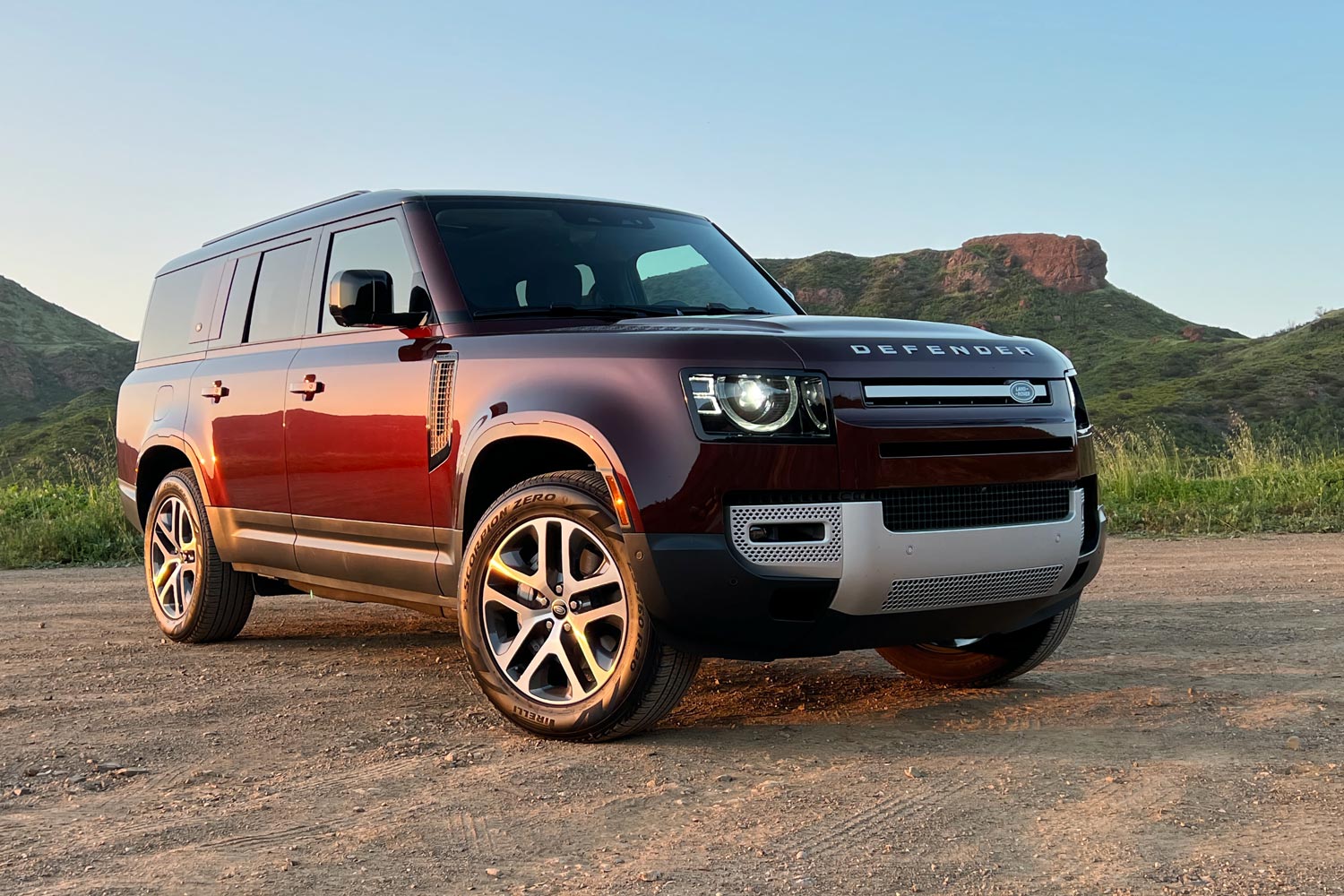 Christian Wardlaw
Christian Wardlaw
Legendary for its off-road capability, the original Land Rover Defender was briefly available in the United States in limited quantities between 1993 and 1997. Since then, Land Rover fans have wanted the model to return to the states. A few years ago, the automaker obliged, reviving the Defender nameplate and attaching it to a modern SUV with exterior styling and interior design inspired by the original.
Today, the Defender lineup includes the two-door 90, the four-door 110, and the new-for-2023 extended-length four-door 130. The Defender 130 sits on the same 119-inch wheelbase as the Defender 110 but is 13.4 inches longer. That extra length allows for a traditional third-row seat, eight-passenger capacity, and more cargo space than the 110.
Although the Defender 130 just debuted, Land Rover is already planning a few changes. For example, adaptive cruise control with lane-centering assist will be standard in 2024. In addition, a new cargo area storage solution debuts, and with some Defender 130 models, you'll need to pay nearly $1,000 for exterior paint colors that are free in 2023. The 130-exclusive Sedona Red shown here is one of them.
The more important news is that Land Rover will expand the 2024 Defender 130 lineup to include a new Outbound edition. The Outbound features five-passenger seating, body-color panels in place of the rear windows, and a flat cargo load floor with 46.9 cu-ft of volume behind the back seat.
In addition, a new 2024 Defender 130 V8 debuts with a supercharged 5.0-liter V8 engine generating 493 horsepower and 450 lb-ft of torque, breathing through quad exhaust outlets. Land Rover says it will accelerate to 60 mph in 5.4 seconds and can blast to a top speed of 149 mph.
 Christian Wardlaw
Christian Wardlaw
As exciting as all of that might be, the subject of this review is the 2023 Defender 130. The lineup includes the S P300, SE P400, X-Dynamic SE P400, First Edition P400, and X P400. Land Rover Defender 130 prices range from just under $70,000 to a little more than $100,000, including the destination charge to ship the SUV from the Nitra, Slovakia, factory that builds it to your local dealership.
For this 2023 Land Rover Defender 130 review, I test-drove the SE P400 in Southern California. It came with upgraded 20-inch wheels with a full-size spare tire, a black roof, and a trailer hitch receiver. In addition, it had a solar-attenuating windshield, four-zone automatic climate control, premium Windsor leather upholstery, and heated and ventilated front seats. Land Rover also added the Cold Climate Pack, the Premium Upgrade Interior Pack, and the Advanced Off-Road Pack.
These extras brought the manufacturer's suggested retail price to $87,525, including the $1,475 destination charge. Land Rover provided the vehicle for this Defender 130 review.
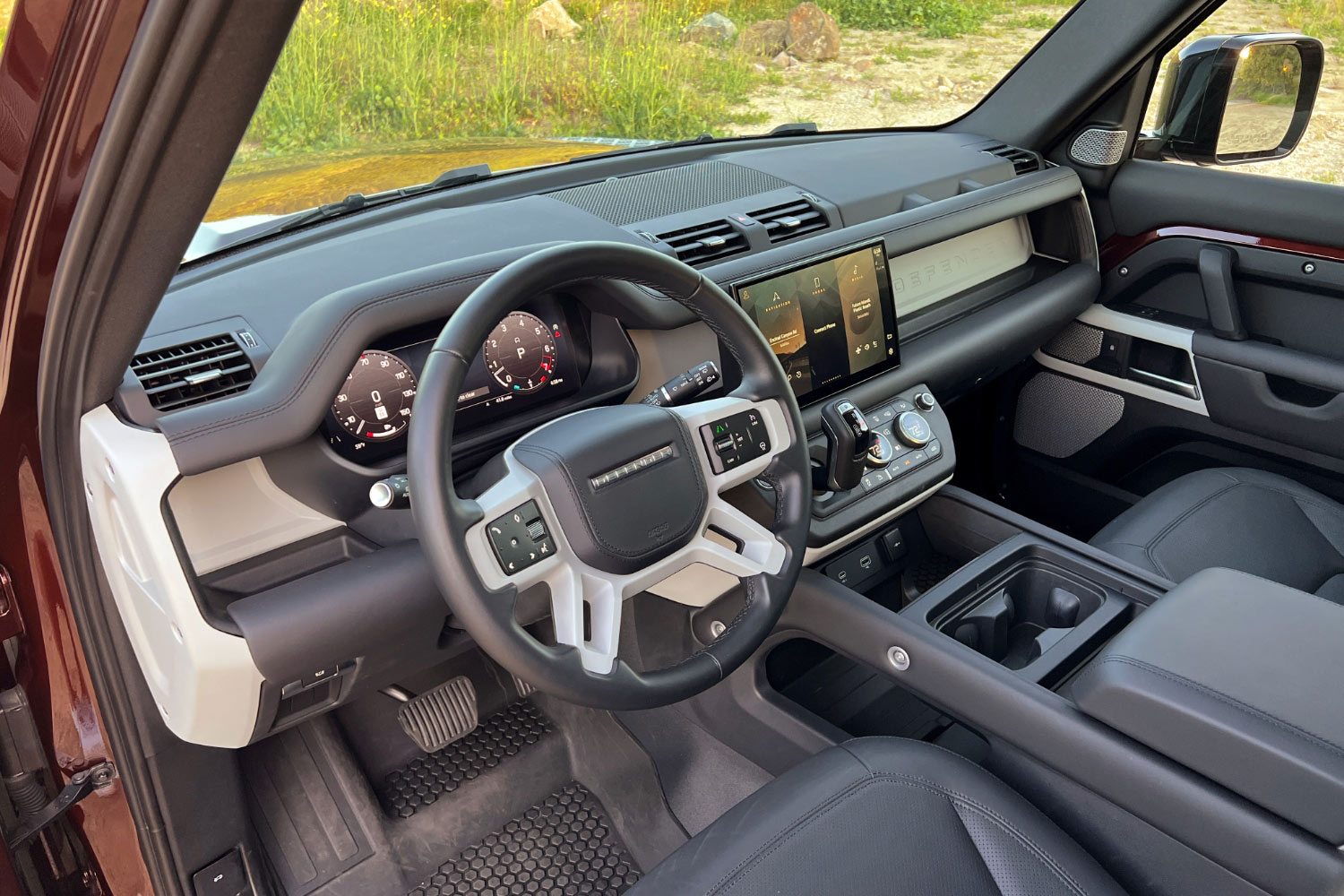 Christian Wardlaw
Christian Wardlaw
Land Rover Defender 130 Features Comfort, Utility, and Plenty of Legroom
All three versions of the Land Rover Defender have a rugged, purposeful, retro appearance. The four-door Defender 110 appears to avoid the stubby look of the two-door 90 and the excessive rear overhang of the three-row 130. Also, the 130 does without the narrow roof windows you get on the 90 and 110, but it includes a standard panoramic sunroof with a separate glass panel over the third-row seat.
While I prefer the proportions of the Defender 110, which is available with a standard five-passenger configuration, a six-passenger arrangement with a front center seat, or with seven-passenger capacity including two small third-row seats, your path to owning a traditional three-row, eight-passenger Defender leads straight to the 130.
Open a door, climb aboard, and the Defender 130 greets you with a practical interior design boasting lots of storage and materials facilitating easy clean up. You can upgrade the interior with premium leather, real wood trim, and four-zone automatic climate control. Even with these extras, however, the Defender retains its industrial-grade ambiance.
Don't assume by its appearance that the Defender's interior is cheaply outfitted. It is not, except perhaps for the plastic front seatback panels that can easily scuff. Land Rover claims it adds a highly durable paint to the interior surfaces, which gives the cabin a sense of quality.
Land Rover clusters the Defender 130's features and functions primarily within the digital instrumentation and infotainment system, with physical controls on the steering wheel, stalks, and a jutting center dashboard surface where the climate controls take center stage.
Standard equipment includes a Cabin Air Purification Plus system with particulate filtration, allergen and pathogen removal, and carbon-dioxide management. In addition, the climate system's temperature knobs serve triple duty. You twist them to adjust the temperature, you push them to activate the seat heating and ventilation, and you can change their function to manually control fan speed or access the Defender's multiple Terrain Response driving modes.
Generally speaking, the digital instrumentation and infotainment menus and settings are logical. However, because the tech is so broad and deep it's easy to forget how to find and use secondary vehicle features. Also, for some reason, Land Rover places the Settings shortcut on the right side of the infotainment screen while all other shortcuts are on the left.
The Defender 130 has a standard air suspension that you can program to kneel into its lowest setting each time you stop the SUV to get out. It remains in that position until you get back in and start the engine. I turned this function off for a photo shoot and never switched it back on. That made for some choice commentary uttered by my better half as she struggled to climb aboard.
The test vehicle's 14-way power-adjustable front seats were like plush, overstuffed dining room table chairs. Comfort and support were outstanding, and long trips were a joy. They were heated and ventilated, too, and the power-adjustable steering wheel offered a heated rim. Storage in the front seating area is excellent, with numerous cubbies, trays, and a shelf running nearly the entire width of the dashboard, all lined with rubber to hold items in place and for easy clean-up. Fortunately, only the bin underneath the center armrest is disappointingly small.
 Christian Wardlaw
Christian Wardlaw
The second-row bench seat isn't quite as rewarding. It offers good space and decent comfort, but the bottom cushion feels too low. Also, the front seatbacks are hard plastic affixed with storage netting, and this combination could prove unkind to the knees and shins of taller people. The test vehicle had two rear climate zones with separate controls and USB-C charging ports. Storage space seemed a little stingy.
Land Rover builds the Defender 130 to provide a traditional third-row bench seat and eight-passenger capacity. However, accessing the extra room is challenging since the SUV uses the same wheelbase as the Defender 110. Clearance is tight, and while Land Rover thoughtfully provides flat surfaces to secure your footing for easier entry and exit, adults are likelier to tumble in and stumble out.
That's too bad because after leaving your dignity and grace at the door, you'll find a reasonably comfortable third-row seat. You sit high with proper leg support, and while your legs and feet fit snugly, the carpeted second-row seatbacks are kind to your knees. You also get large side windows, air-conditioning vents, and your own overhead sunroof panel. Better yet, there is decent crush space between the third-row head restraints and the back glass, just in case an inattentive driver plows into the back of the Defender 130.
 Christian Wardlaw
Christian Wardlaw
To access the cargo area, you must swing the heavy tailgate door open, making sure not to clobber anyone with the spare tire hanging on it. It opens from left to right, making it difficult to use when the Defender is in a parallel parking space or a stacked-and-packed parking situation, such as at the Hollywood Bowl. There is no underfloor storage space, but the tailgate panel does have a wide tray for smaller items.
Buttons within the cargo hold can lower the air suspension to create a lower load height. However, when you fold the 40/20/40-split third-row seat to expand cargo space from 15.3 cubic feet to 35.8 cu-ft, the result does not create a flat load floor. Plus, you must manually collapse the third-row head restraints before releasing and dropping the seatbacks. My family picked up the SUV at the airport following a trip, and it was a comical scene as the valet, my wife, my kids, and I jockeyed for position around the tailgate while trying to figure out how to get the seats flat and load the luggage.
If you need more room, you can fold the second-row seats to create 76.1 cu-ft of cargo space.
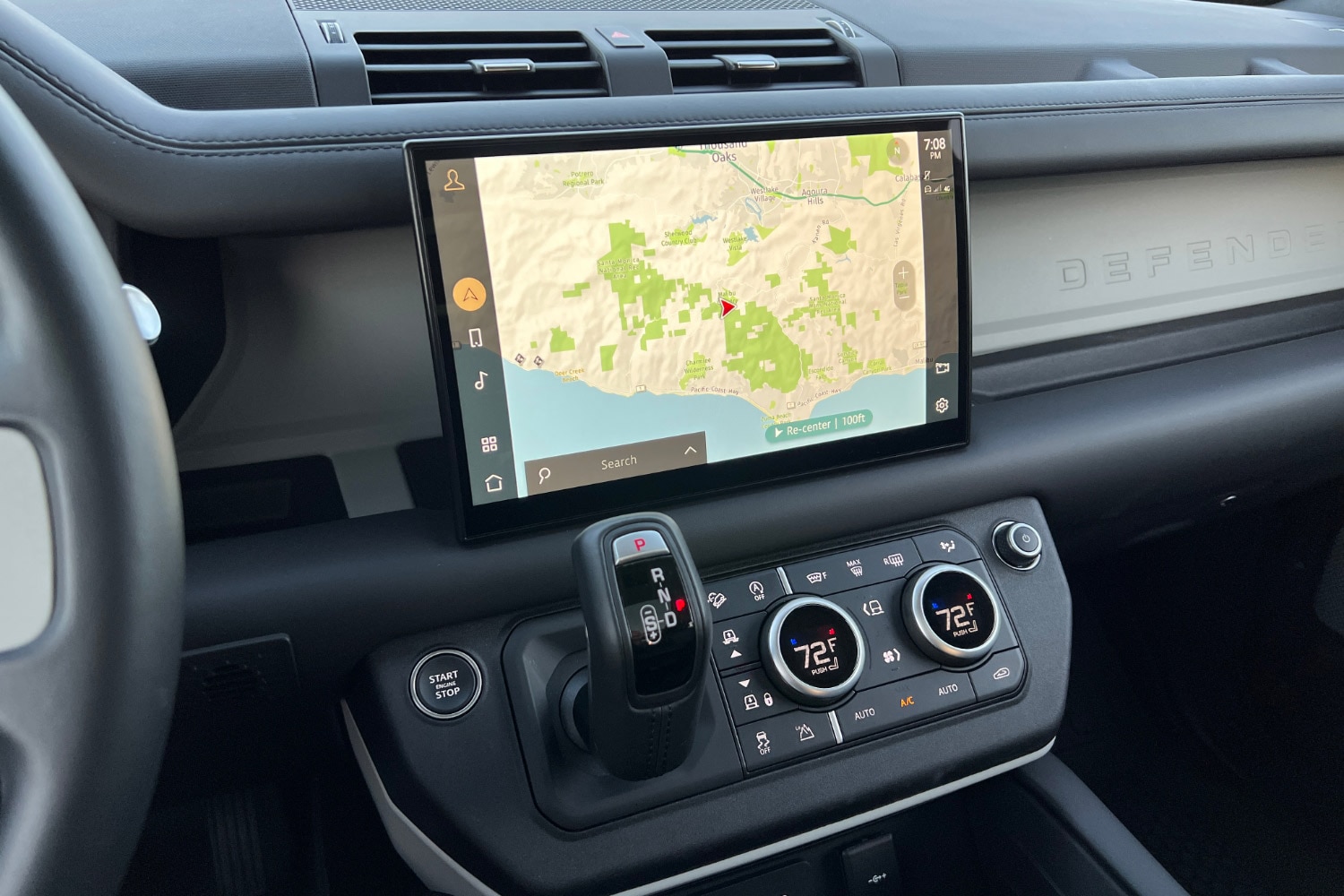 Christian Wardlaw
Christian Wardlaw
The Defender 130 Is Packed to Its High Roof With Tech
At a glance, the most technologically advanced items within a Defender 130 are the 12.3-inch digital instrumentation panel and 11.4-inch touchscreen Pivi Pro infotainment system. In addition, the Defender 130 has a surround-view camera system with a ClearSight ground-view function to help when you're off-road. Upgrades include a head-up display and a ClearSight digital rearview mirror, but my test vehicle did not have these extra-cost options. The mirror would have been helpful.
Land Rover says Pivi Pro's home screen is configurable and that the system accepts over-the-air software updates, can learn owner habits and adapt to them, and provides "fast, state-of-the-art functionality." It includes Bluetooth, wireless Apple CarPlay and Android Auto compatibility, SiriusXM satellite radio, navigation, and an Online Pack with connected services and data plan, including Amazon Alexa, Spotify, and more. Access to a Wi-Fi hotspot is available as an upgrade, and an impressive 14-speaker Meridian premium sound system is standard.
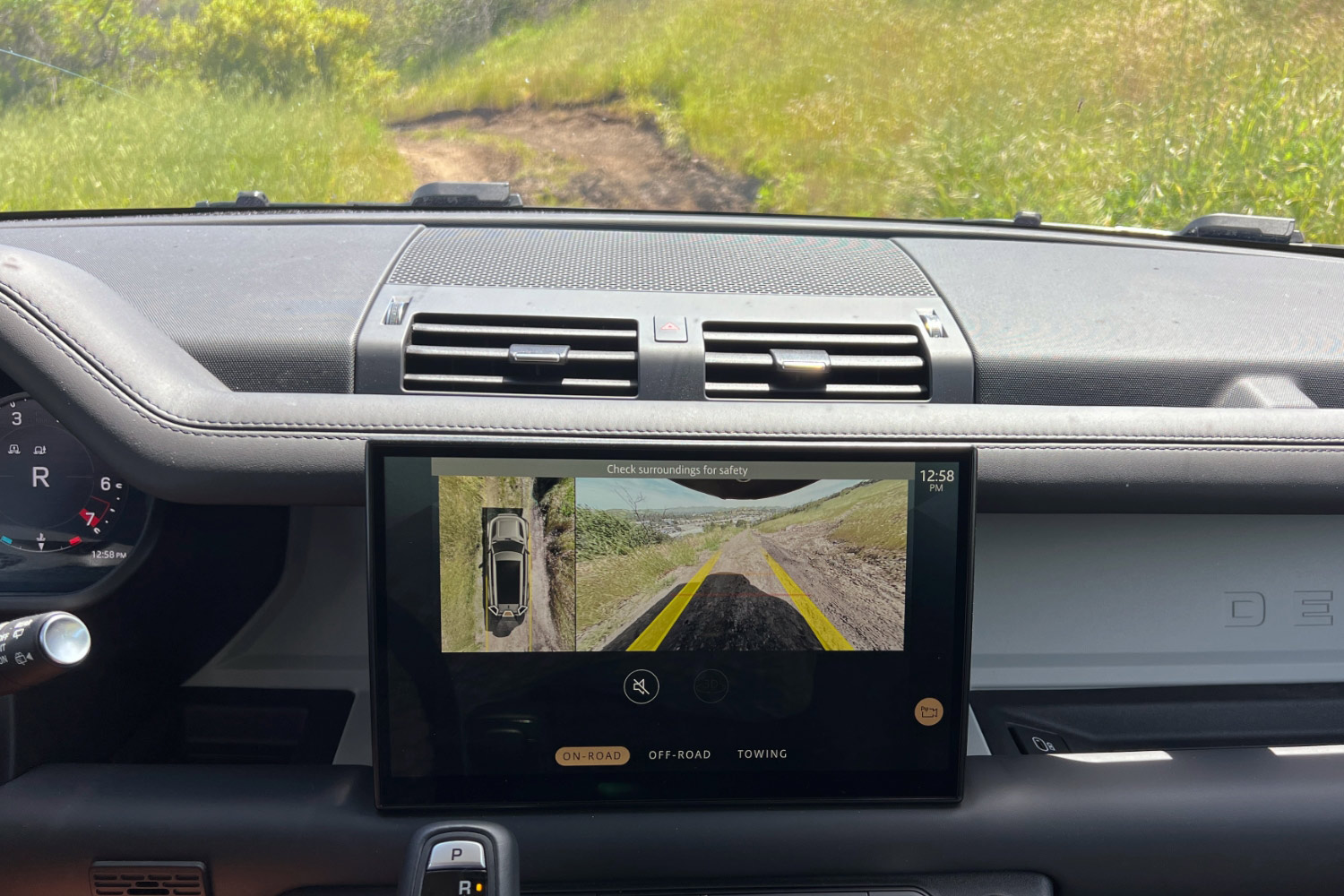 Christian Wardlaw
Christian Wardlaw
While Pivi Pro mostly arranges its seemingly endless menus of functions and features logically and you can customize the user experience to some degree, it can nevertheless cause confusion and irritation. For example, the Driver Assistance settings live four layers deep within a Settings main menu that resides separately from the other shortcuts. Fortunately, a button on the steering wheel turns the lane-keeping-assist system off, saving you some money on anger management therapy.
In addition, while I had no trouble pairing my iPhone to run Apple CarPlay, I couldn't quickly figure out how to exit CarPlay to return to the native Pivi Pro environment. Indeed I must have missed something obvious, but often there is a menu shortcut with access to the native software or a home icon that lets you backtrack to the primary system's Home screen. Unfortunately, those appeared to be missing in the Defender. So, I unpaired my phone and did not use CarPlay.
Pivi Pro's standard voice recognition technology seems as though it should be a conversational technology, but it isn't. Instead, you must follow onscreen prompts to achieve objectives, such as finding a local Starbucks or getting directions to the nearest hospital. I tried to program a route to the White House using the street address, but Pivi Pro wasn't up for it, and I didn't have the patience.
In addition, the system often misinterpreted my Michigan accent, producing unwanted responses and actions. And because the response time to voice commands is slow, you're forced to wait for the voice assistant to fail. No fun.
I recommend setting up Amazon Alexa or simply running Apple CarPlay or Android Auto, though using the latter platforms might prove challenging since Land Rover bakes so much of the Defender's functionality into the Pivi Pro screen.
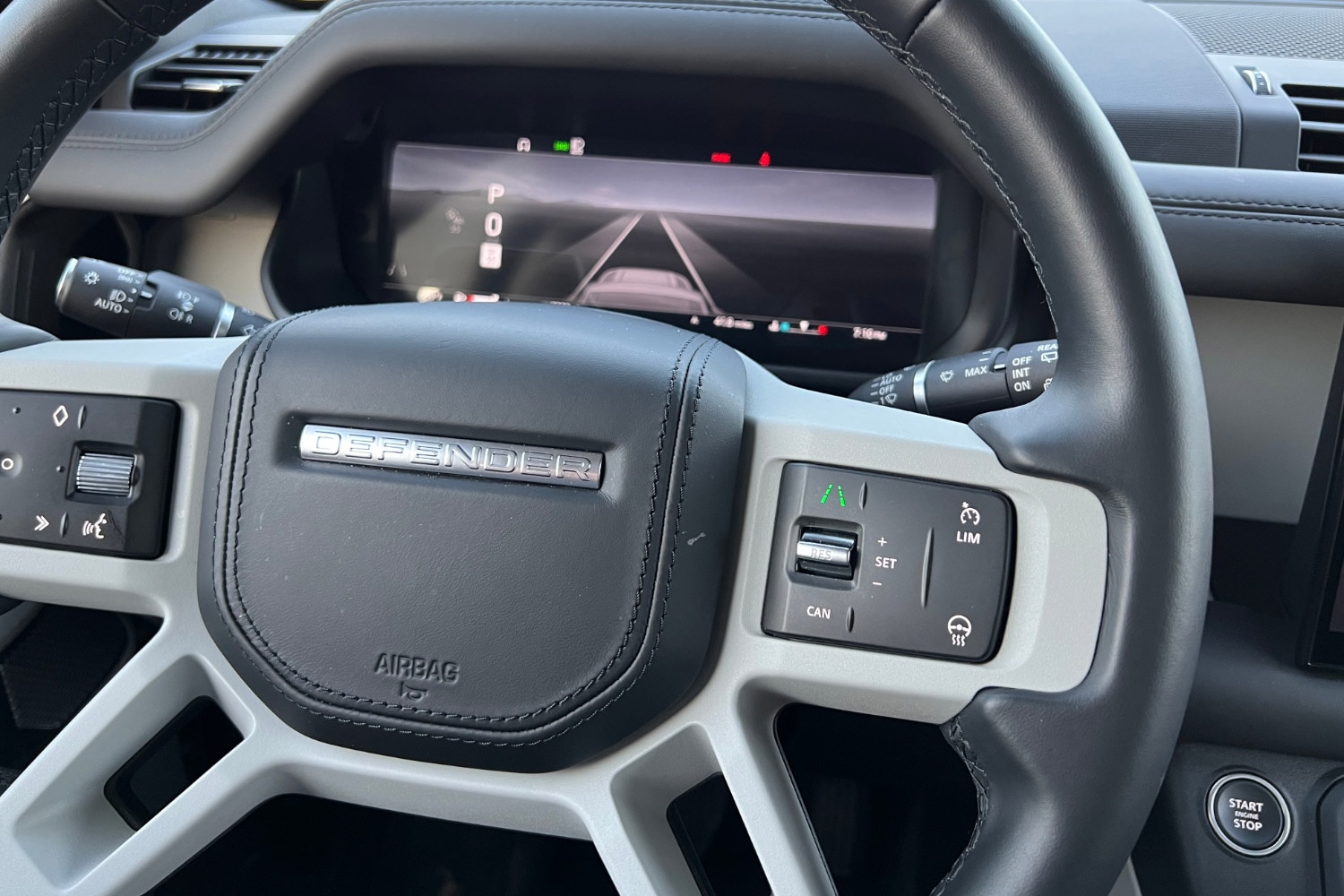 Christian Wardlaw
Christian Wardlaw
As far as safety features, my Defender 130 came with the following standard systems:
- Forward-collision warning
- Automatic emergency braking
- Lane-departure warning
- Lane-keeping assist
- Blind-spot monitoring
- Rear cross-traffic alert
- Driver monitoring system
- Traffic sign recognition system
- Front and rear parking sensors
- Surround-view camera with 3D perspectives
- Emergency collision notification
You'll notice it does not have the available adaptive cruise control system with lane-centering assist. However, both will be standard on the 2024 Land Rover Defender 130.
Based on what I could sample, my only complaints about the Defender 130's safety systems pertain to lane-keeping assist. It can be aggressive with its steering input, so the driver must act quickly and decisively to override it when necessary. For example, it resists giving cyclists and parked cars a wider berth. Also, it was a constant aggravation on a narrow farm road without shoulders. That's why it's a good thing Land Rover makes it easy to turn this feature on and off using a button on the steering wheel.
As of this writing, the National Highway Traffic Safety Administration and the Insurance Institute for Highway Safety have not conducted crash tests on the Defender 130.
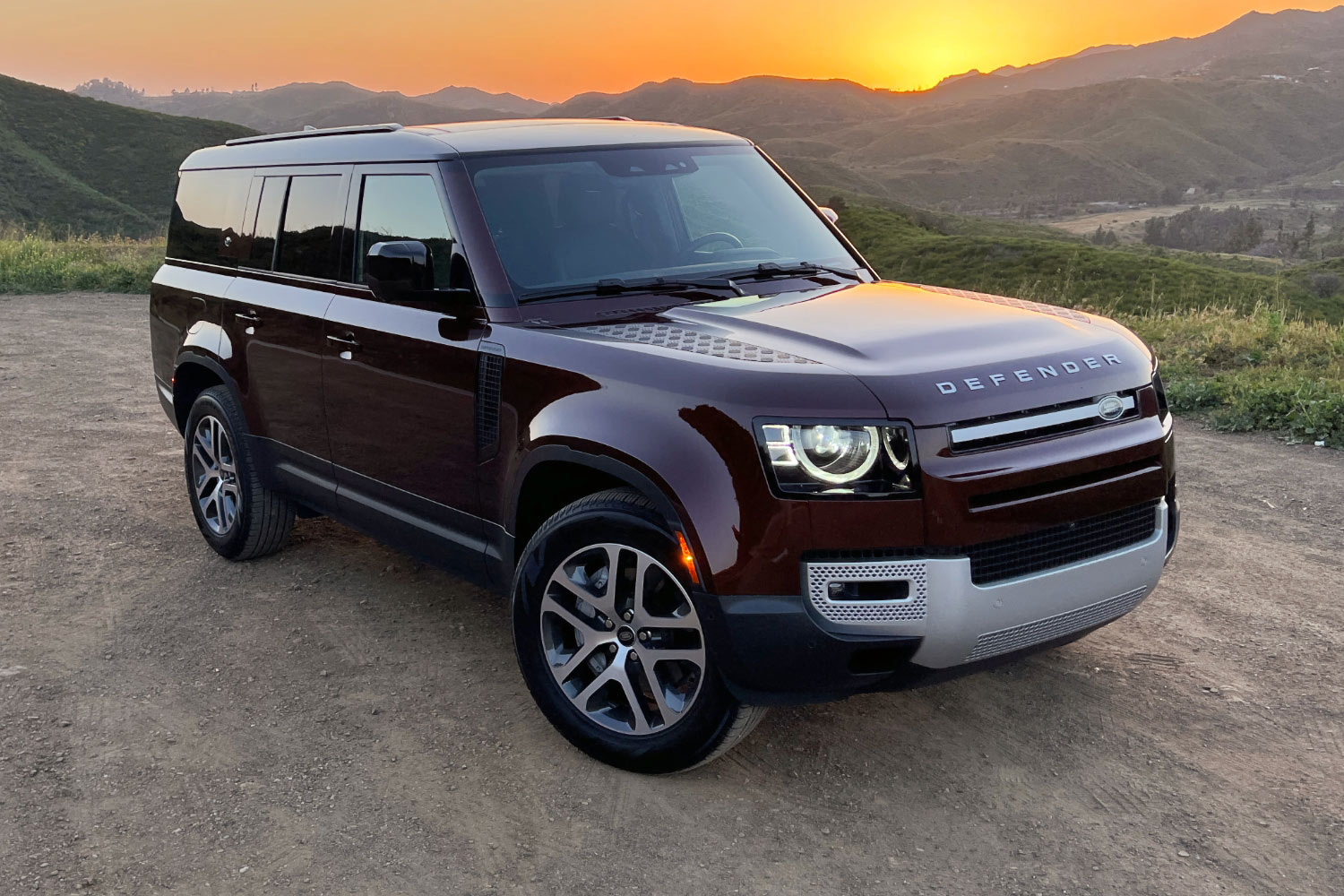 Christian Wardlaw
Christian Wardlaw
Discover the Defender 130's True Nature Off the Beaten Path
A turbocharged 3.0-liter inline six-cylinder engine is standard in the 2023 Defender 130, equipped with mild-hybrid technology, including a 48-volt integrated starter generator. In the base Defender 130 S P300, the engine supplies 296 horsepower and 347 lb-ft of torque. In all P400 models, it delivers 395 horsepower and 406 lb-ft of torque.
In addition, both engines employ an eight-speed automatic transmission, Land Rover's Intelligent All-Wheel Drive with a low-range function, and Terrain Response driving modes that adjust vehicle settings depending on the surface type. Terrain Response modes include Eco, Comfort, Grass Gravel Snow, Mud Ruts, Sand, Rock Crawl, and Wade.
According to Land Rover, the 5,570-pound Defender 130 P400 accelerates to 60 mph in 6.3 seconds, tows 8,200 pounds, and carries a 1,760-pound payload. The dynamic roof-load rating measures up to 370 pounds with the Defender's available all-terrain tires, and thanks to a 661-pound static load rating, you can use a roof tent with this SUV. The EPA says the Defender 130 P400 gets 19 mpg, but the SUV returned 16.1 mpg on my testing loop. However, that fuel economy result included plenty of off-roading
An Adaptive Dynamics air suspension is standard on the Defender 130, providing 16.9 inches of maximum wheel articulation and 11.5 inches of maximum ground clearance. Due to the 130's added length, Land Rover gave the SUV a subtle boat-tail lift at the rear to help preserve the departure angle, which measures 28.5 degrees. The 130's approach angle is 37.5 degrees, and the breakover angle is 27.8 degrees. In addition, the Defender 130 can ford 35.4 inches of water, and the standard Wade Sensing function can help you understand how deep the water is and will become.
I like driving the Defender 130. You enjoy a commanding position over surrounding vehicles from the driver's seat, and the excellent forward visibility adds confidence. In addition, the turbocharged mild-hybrid powertrain makes the Defender feel quick when accelerating, and the adaptive air suspension does an admirable job of controlling unwanted body motions, especially over speed humps and bumps. The 130 is unexpectedly quiet on the highway as well. Overall, it comes across as a stable, secure, and refined SUV ready to pummel poorly maintained pavement into submission.
While the ride and handling are impressive for a heavy and tall vehicle, a passenger of mine complained about lateral rocking that I didn't sense. In addition, on the narrow lanes of Los Angeles freeways, I thought the steering was a little too sensitive and responsive, resulting in sharper inputs than you typically want in a traditional, top-heavy SUV. In traffic, the brakes were also a little grabby, and the SUV could surge forward with surprising speed as the peak torque arrived, but these were manageable issues.
This SUV is surprisingly easy to park thanks to a clear view of the Defender 130's front corners and its standard surround-view camera. However, I recommend getting the camera-based ClearSight rearview mirror because the spare tire and the rear head restraints severely restrict the view to the back. Also, and this is an odd observation, the upright windshield collects more bugs than most luxury SUVs.
As I do with every test vehicle, I took the Defender 130 down Mulholland Highway in the Santa Monica Mountains. That is not the Land Rover's natural habitat, but it proved competent if not engaging to drive on a twisty and sometimes lumpy canyon road. The air suspension limits most unwanted body motions in this environment. Still, I wouldn't be surprised to learn that Land Rover engineers might tune it to allow some roll and weight transfer to keep a driver's behavior in check. And the stability control isn't shy about introducing itself from time to time.
I also went off-roading in the Defender 130. Southern California weathered a harsh winter with downpours of welcome rain, but most local trails became unsafe and impassable until recently. So, I selected the Mud Ruts driving mode, raised the suspension, left the all-wheel-drive system in automatic mode, and headed up a known trail.
 Christian Wardlaw
Christian Wardlaw
Maybe I should have expected it, but this SUV provided a level of capability and refinement I haven't experienced since test-driving a Defender 90 a few years ago. As such, I ventured along that trail deeper into the mountains than I'd traveled before, enjoying the smooth accelerator response as I slowly picked my way over and between the rocks.
Ultimately, a stretch of wet, gooey, and potentially thick remnants of winter forced me to stop and go back. Reversing the SUV down the trail was pretty easy, thanks to the cameras and excellent visibility down and to the sides of the Defender 130. When I reached a wide-enough spot to accommodate turning around, the cameras and parking sensors allowed this maneuver without a scratch.
Descending to civilization with the hill-descent control system restricting my speed, I had a big smile on my face. In the Defender 130, I safely and confidently tackled some of the most intense off-roading I've performed locally. Could the Land Rover have churned through the mud and muck that convinced me to turn back? Undoubtedly. But I'm a big believer in being safe rather than sorry.
 Christian Wardlaw
Christian Wardlaw
Is the 2024 Land Rover Defender 130 a Good SUV?
The new Land Rover Defender 130 is a legitimate rival to other three-row luxury SUVs, and in exchange for what it gives up in outright on-pavement performance to a BMW X7 or Mercedes-Benz GLS, it earns back when the going gets rough and tough. However, be sure you're choosing a Defender primarily for its design, utility, and off-roading capability. If what you seek is sumptuous luxury, this SUV will likely disappoint.
While I like the Defender 130, I wouldn't buy it over the Defender 110. To my eye, the 110 has a more balanced appearance, and it offers nearly as much cargo space as the 130. In addition, you can get the 110 in three seating configurations, including a two-row six-passenger arrangement with a front bench seat, which I really love.
But, as I said earlier, if you want a traditional third-row seat and maximum cargo space in a Land Rover Defender, the 130 is the way to go.
Written by humans.
Edited by humans.
 Christian Wardlaw
Christian WardlawMy first word was “car.” That’s what I’m told, anyway. For as long as I can remember, I’ve been obsessed with them. The design. The engineering. The performance. And the purpose. I’m a car enthusiast who loves to drive, but I’m also most interested in the cars, trucks, and SUVs that people actually buy. Anybody can tell you that a sports car is fast. What you need to know is whether or not you should buy that new SUV, and why. My life purpose is to help you make that decision.
Related articles
View more related articles